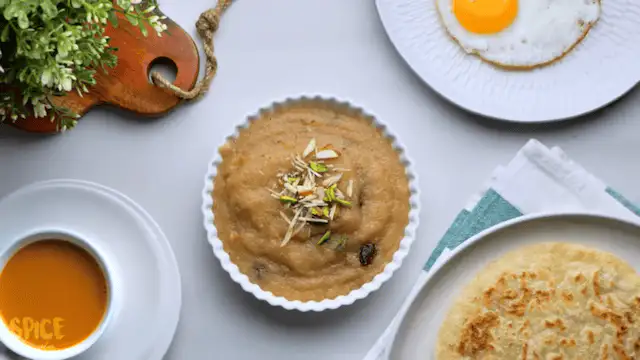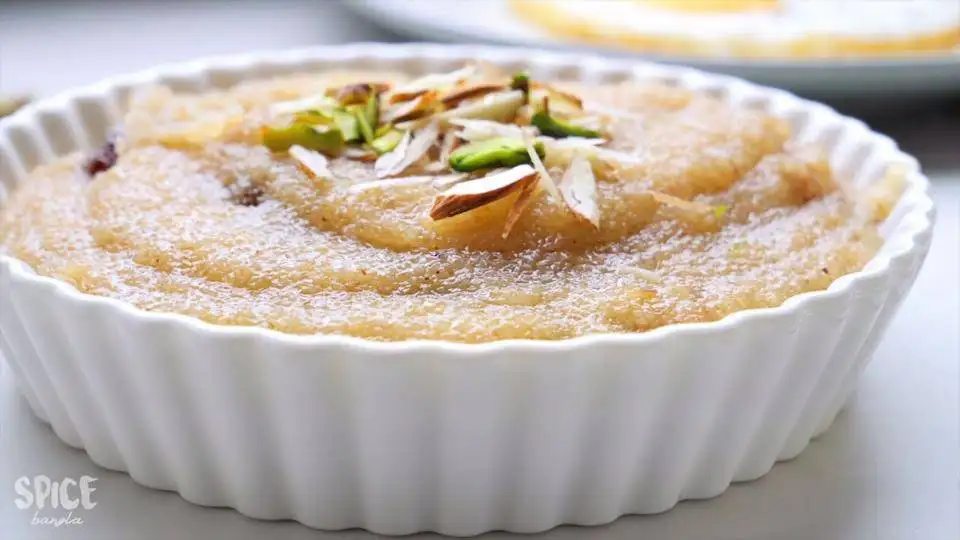Semolina halwa, otherwise known as Suji/ Sooji Halwa, is more than just a dessert. For me, every spoonful of this halwa takes me back to my childhood home, where the aroma of roasted suji, buttery ghee, and fragrant spices would fill the air!
Suji/ Sooji ka halwa is a traditional dish popular in South Asia and the Middle East. This dessert is served especially during celebrations and festivities or as a sweet treat for breakfast or snacks.
One of the reasons semolina is so popular is how incredibly easy it is to prepare! With just a few basic staples—suji, sugar, and water—you can prepare the basic halwa recipe that’s rich in flavor and has a delicate texture. In addition to this simple version, you can add many things to customize and make it taste even better.

Personally, I love tossing in raisins and pistachios for extra sweetness and crunchiness. You can also add your favorite toppings, such as dried fruits, almonds, cashews, coconut flakes, etc., to enhance its texture and flavor. The best part? This delicious treat only needs 15 minutes to prepare!
Mastering The Art Of Roasting Semolina/ Suji
Every recipe has some key points that make all the differences to the dish. Nail those points right and the rest of the cooking might feel like a breeze!
Roasting semolina is a crucial step that can be the difference between a light, fluffy halwa and one that’s sticky and bland. Roast the suji right and you are already halfway to a delicious dessert! Here are some techniques you can apply to roast semolina perfectly:
- Choose a heavy-bottomed pan to roast suji. A thick pan allows the semolina to get roasted slowly and helps distribute the heat evenly. As a result, the semolina won’t stick to the bottom or burn and the suji will roast to a beautiful golden color for the halwa.
- Keep the temperature medium low heat as the recipe suggests. The semolina gets roasted pretty quickly and may burn if you keep the temperature too high. Maintain a consistent heat throughout the cooking and have patience to enjoy a well-developed flavor of the halwa.
- While roasting the suji, which typically takes about 7-8 minutes, stir continuously to prevent the semolina from browning too quickly. If the semolina gets roasted too quickly, it may cook unevenly resulting in some portions of the semolina getting burned while other parts remain undercooked.

To know when the suji is done cooking, check its color and aroma. If it’s too dark, the halwa will taste bitter, and if it’s too light, the suji will taste bland. When the color turns from pale white to light golden, and you smell that rich, nutty aroma, the suji is roasted perfectly!
- If you are still unsure whether the suji is done, take a small pinch between your fingers and try to feel its texture by gently rubbing. Properly roasted suji feels a little grainy and dry, undercooked suji feels too gritty, and overcooked suji tastes bitter.
- To give your semolina halwa a unique twist, add cardamom powder or a pinch of ground cinnamon just before you are done roasting. Adding these spices helps enhance the flavor of semolina and transforms it into a fragrant treat.
Semolina Halwa Recipe As A Sweet Dessert or As A Healthy Breakfast?
Although halwa can be enjoyed any time of the day, it’s most commonly served as a dessert or as a healthy item for breakfast. The basic version of the halwa is delicious enough, however, you can customize according to when you prefer to have this treat.
Here are some suggestions to customize the semolina halwa for a sweet dessert and a healthy breakfast.
For desserts, you can give the halwa a rich flavor profile by using a generous amount of ghee and sugar. The flavor is further enhanced by classic spices like cardamom, saffron and cinnamon. You can also use rosewater to add a touch of floral note to the halwa. If you are making this dessert for kids, consider adding chocolate drizzle for extra sweetness. You can also use dark chocolate for a bittersweet contrast.

For a healthy breakfast, you can reduce the amount of sugar used in this recipe for a diet-friendly start in the morning. Consider cutting the recommended amount in half, which is ¼ cup for this recipe and enjoy a less sugary breakfast treat. To compensate for the lack of sugar, you can add fresh and dried fruits which are full of nutrients and naturally sweet. Try mixing in sliced apples, dates, mashed bananas, raisins etc. into the halwa for added fiber and vitamin.
If you find the suji is too sweet after you are done with cooking, balance the sweetness with a dollop of yogurt on the side easily. You can also sprinkle some nuts like toasted almonds, cashews and pistachios on top for extra crunch and balancing the sugar with an earthy flavor that contrasts the sweetness.

Make Suji Halwa in just 15 Min | Shuji Halwa Recipe | Quick Rava Halwa Recipe
Ingredients
- ½ cup / 90 g Clarified butter (Ghee)
- ½ cup / 85 g Semolina (Suji)
- ½ cup / 100 g Sugar
- 3 piece Cardamom
- 1 stick Cinnamon stick
- 1 tbsp / 8 g Chopped pistachios
- 1 tbsp / 10 g Chopped almonds
- 1 tbsp / 15 g Raisins
- 2 cups / 474 ml Water
Instructions
Melt Clarified Butter
- First, melt the ghee (clarified butter) in a large frying pan on low heat. You can reduce the amount of the ghee if you like.
- Put the cinnamon stick and cardamoms in the ghee and fry for 30 seconds. You can alternatively use cardamom and cinnamon powder here, but in that case, add them to the end.
Roast Semolina In Ghee
- Now, add the semolina to the ghee and fry for 7-8 minutes on medium low heat.
- Keep stirring them constantly until they become slightly brown and a pleasant aroma comes out of them.
Add Nuts, Sugar, And Water
- Now add the chopped pistachio, almonds, and raisins to the suji and fry for 30 seconds.
- Then add the sugar, followed by 2 cups of hot water. Increase the amount of sugar if you like it very sweet.
- Now cook for about 5 minutes on medium-low heat until the water dissolves and the semolina is fully cooked.
Serve And Enjoy!
- Garnish the halwa with more chopped dry fruits of your choice.
- Otherwise, you can add chopped nuts or whatever you like to add then serve and enjoy!
Video
Semolina halwa is a simple yet versatile dish that fits every occasion. Be it a celebration or a cozy weekend breakfast, suji halwa can be adapted very easily! This dessert allows you to get creative without any extra hassle. From dried fruits to crunchy nuts, you can customize it as much as you want and add a unique, personal touch to your favorite treat.
Recipe FAQs
How Do I Store Semolina / Suji Halwa?
You can store semolina halwa in an airtight container and keep it in the refrigerator for up to 3-4 days.
Why Is My Suji Too Sticky?
You probably haven’t roasted the suji long enough. Try adding a bit more ghee and stir continuously over medium heat to prevent it from becoming sticky.
Can I Make This Sooji Halwa Without Sugar?
Yes, you can reduce the amount of sugar or replace sugar with natural sweeteners like honey or maple syrup to make this delicious halwa dessert.


Leave a Reply